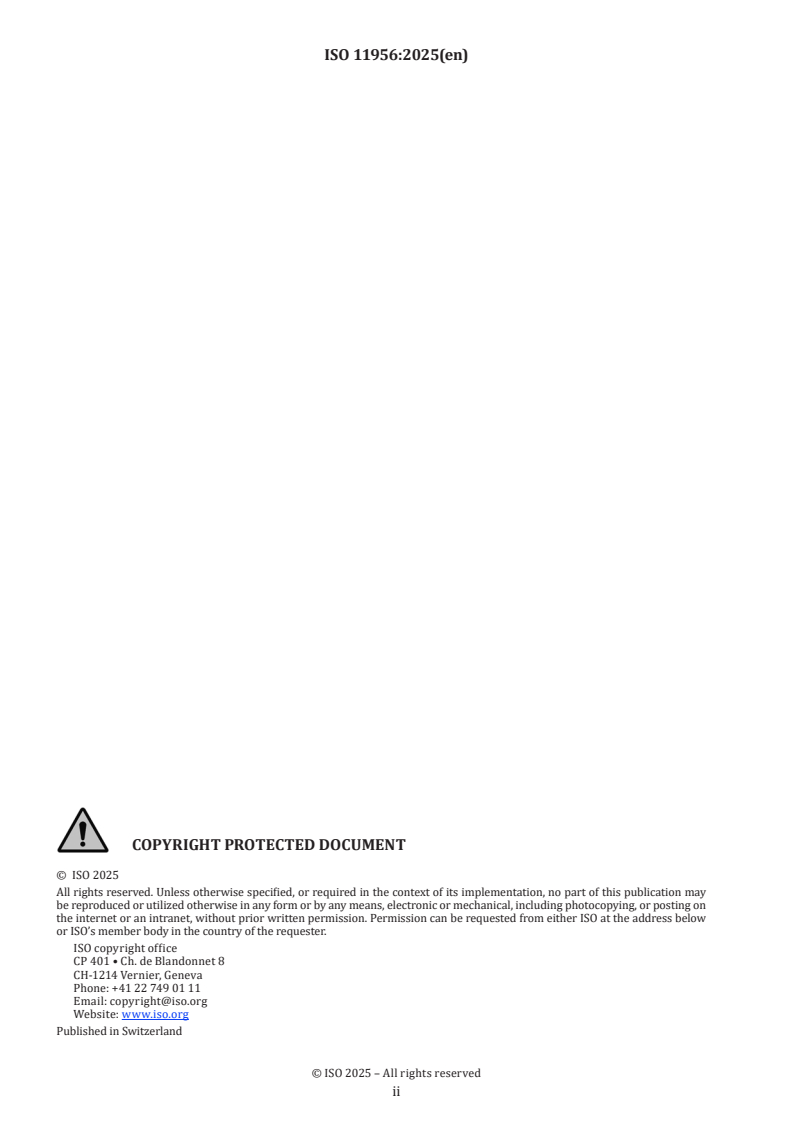ISO 11956:2025
(Main)Adventure tourism — Cyclotourism — Requirements and recommendations
Adventure tourism — Cyclotourism — Requirements and recommendations
This document establishes requirements and recommendations for adventure tourism involving cyclotourism [e.g. road bike, mountain bike, gravel bike, bikepacking or fatbike, including electrically power assisted cycles (EPAC) and mountain EPAC], relating to the safety of participants, leaders and assistants. This document also establishes criteria relating to characteristics and difficulty levels for cyclotourism route classification. This document applies to cyclotourism offered as a tourism product. Tourism product design involves a product planning and development phase that is not covered in this document. Some tourism products include cyclotourism combined with other tourism services (e.g. transfers, meals, lodging), but this document applies only to cyclotourism. Additional tourism services are excluded from the scope. This document is applicable to any kind of adventure tourism activity provider that offers tourism products consisting of cyclotourism. This document is not applicable to sportive cycling activities (including mountain biking in bike parks or in ski areas), bicycle rentals or bicycle sharing use (i.e. bicycle rental for urban or rural mobility) with no adventure tourism purposes. This document does not cover the maintenance and repair work of the bicycle.
Tourisme d'aventure — Cyclotourisme — Exigences et recommandations
General Information
Standards Content (Sample)
International
Standard
ISO 11956
First edition
Adventure tourism —
2025-05
Cyclotourism — Requirements and
recommendations
Tourisme d'aventure — Cyclotourisme — Exigences et
recommandations
Reference number
© ISO 2025
All rights reserved. Unless otherwise specified, or required in the context of its implementation, no part of this publication may
be reproduced or utilized otherwise in any form or by any means, electronic or mechanical, including photocopying, or posting on
the internet or an intranet, without prior written permission. Permission can be requested from either ISO at the address below
or ISO’s member body in the country of the requester.
ISO copyright office
CP 401 • Ch. de Blandonnet 8
CH-1214 Vernier, Geneva
Phone: +41 22 749 01 11
Email: copyright@iso.org
Website: www.iso.org
Published in Switzerland
ii
Contents Page
Foreword .v
Introduction .vi
1 Scope . 1
2 Normative references . 1
3 Terms and definitions . 1
4 Service requirements . 5
5 Leadership . 6
5.1 Leader qualifications .6
5.2 Assistant qualifications .7
5.3 Cyclotourism operation without support vehicle .7
5.4 Cyclotourism operation with support vehicle .7
5.5 Self-guided cyclotourism operation .8
6 Participants . 8
6.1 Profile collection .8
6.2 Information analysis .9
7 Equipment . 9
7.1 Equipment availability and quantities .9
7.1.1 General .9
7.1.2 Collective equipment .10
7.1.3 Individual equipment .11
7.2 Equipment maintenance, cleaning and sanitizing .14
8 Participant preparation . 14
8.1 Information for participants .14
8.1.1 General .14
8.1.2 Knowledge of risks and responsibilities . 15
8.2 Participant instruction . 15
9 Safety and insurance requirements .16
9.1 General .16
9.2 Prevention of risks and safety measures .17
9.3 Communication .18
9.4 Specific requirements for self-guided cyclotourism routes .18
10 Requirements for overnight products . 19
11 Risk management .20
11.1 Risks analysis and assessment. 20
11.2 Hazard and risk assessment . 20
11.3 Risk treatment .21
11.4 Emergency preparedness and response .21
12 Service completion .22
13 Service control .22
13.1 General requirements and recommendations . 22
13.2 Records . 23
13.2.1 Maintaining a registration system . 23
13.2.2 Records of suggestions and feedback . 23
13.2.3 Incident recording, including accidents . . 23
13.3 Procedures .24
13.4 Critical service review .24
14 Social and environmental mitigation and conservation .25
15 Cyclotourism route classification .25
iii
15.1 General requirements . 25
15.2 Classification criteria . 25
15.3 Classification procedures . 26
15.3.1 General . 26
15.3.2 Severity of the environment . 26
15.3.3 Route navigation orientation .27
15.3.4 Terrain conditions . 28
15.3.5 Physical exertion . 29
15.4 Classification communication . 33
Annex A (informative) Cyclotourism route classification reference table .34
Annex B (informative) Cyclotourism route classification form .35
Bibliography .38
iv
Foreword
ISO (the International Organization for Standardization) is a worldwide federation of national standards
bodies (ISO member bodies). The work of preparing International Standards is normally carried out through
ISO technical committees. Each member body interested in a subject for which a technical committee
has been established has the right to be represented on that committee. International organizations,
governmental and non-governmental, in liaison with ISO, also take part in the work. ISO collaborates closely
with the International Electrotechnical Commission (IEC) on all matters of electrotechnical standardization.
The procedures used to develop this document and those intended for its further maintenance are described
in the ISO/IEC Directives, Part 1. In particular, the different approval criteria needed for the different types
of ISO document should be noted. This document was drafted in accordance with the editorial rules of the
ISO/IEC Directives, Part 2 (see www.iso.org/directives).
ISO draws attention to the possibility that the implementation of this document may involve the use of (a)
patent(s). ISO takes no position concerning the evidence, validity or applicability of any claimed patent
rights in respect thereof. As of the date of publication of this document, ISO had not received notice of (a)
patent(s) which may be required to implement this document. However, implementers are cautioned that
this may not represent the latest information, which may be obtained from the patent database available at
www.iso.org/patents. ISO shall not be held responsible fo
...








Questions, Comments and Discussion
Ask us and Technical Secretary will try to provide an answer. You can facilitate discussion about the standard in here.